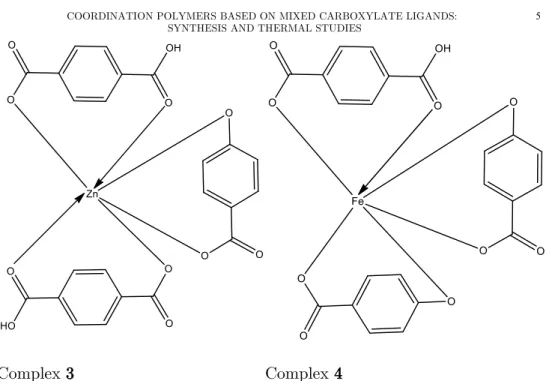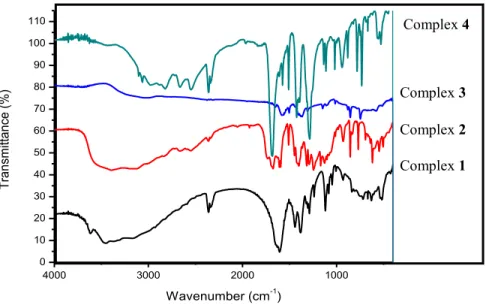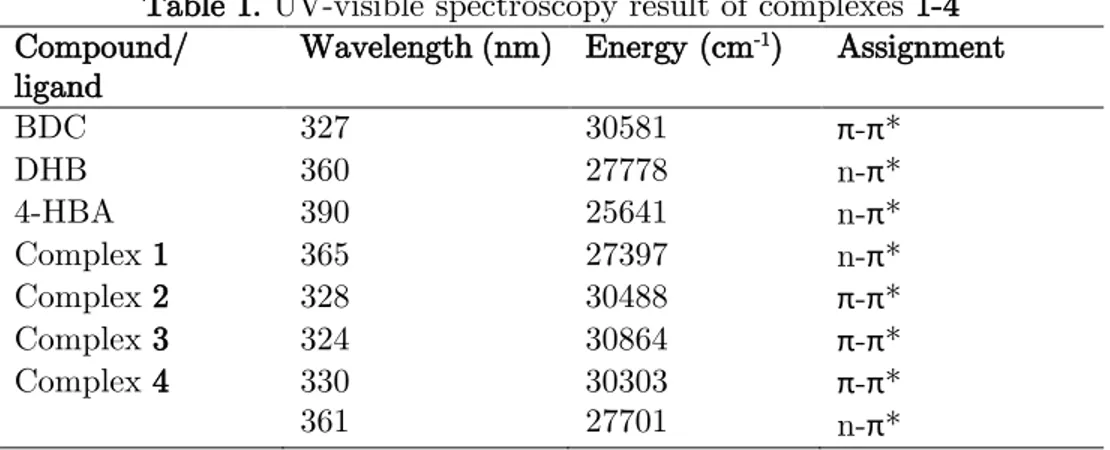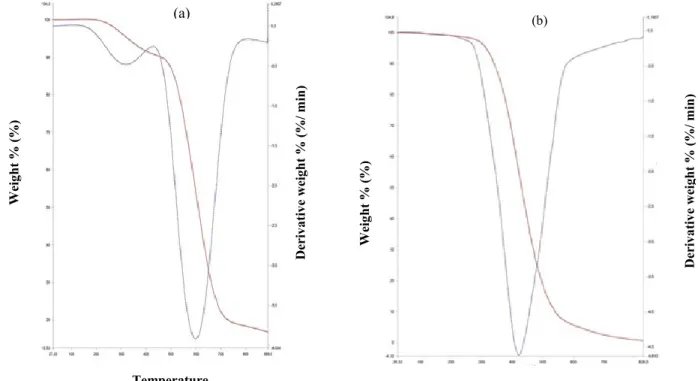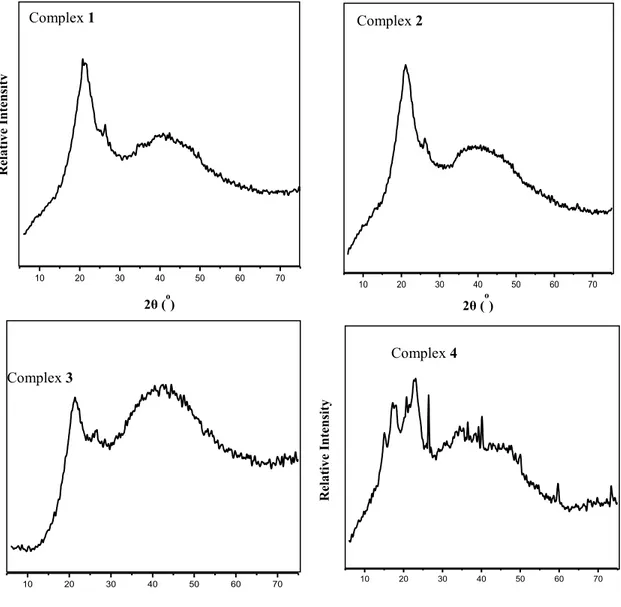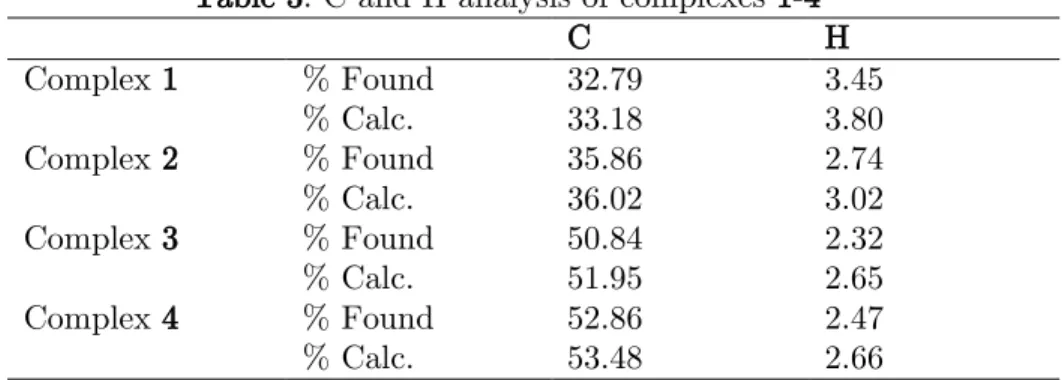Volume 60, Number 2, Pages 1-16(2018) DOI: 10.1501/commub_0000000558 ISSN 1303-6017
http://communications.science.ankara.edu.tr/index.php?series=B
Received by the editors: September 09, 2018; Accepted: December 15, 2018.
Key word and phrases: Metal complexes, Solvent-based method, Terephthalic acid, Thermal studies
© 2018 Ankara University Communications Faculty of Sciences University of Ankara Series B: Chemistry and Chemical Engineering
COORDINATION POLYMERS BASED ON MIXED CARBOXYLATE LIGANDS: SYNTHESIS AND THERMAL STUDIES
Vincent O. ADIMULA, Adedibu C. TELLA, Ifechukwu C. UDEAJA, Abolaji T. DURODOYE, and Amudat LAWAL
Abstract.The synthesis of Co(II), Cu(II), Fe(II) and Zn(II) based coordination compounds using terephthalic acid (BDC), tartaric acid (DHB), and 4-hydroxybenzoic acid (4-HBA) as ligands by a solvent-based and solvent-free methods were reported. Thermal studies of the complexes performed in the temperature range of 30 ºC-950 °C showed a 9.406% weight loss observed between 200 ºC-517 ºC for [Co(DHB)(4-HBA)] complex, and a 1.883 % weight loss observed between 80 ºC-352.68 ºC for [Cu(DHB)(4-HBA)] complex.
1. Introduction
Porous materials generally are solids which have pores in their frameworks which act as spaces that can accommodate other guest molecules [1]. Organic carbon (i.e. activated carbon) and zeolites (inorganic frameworks) are the commonly known porous materials. Activated carbon is known to have high surface areas and high adsorption capacities; however, it lacks an ordered structure. Despite this limitation, porous carbon materials have found applications in various processes which include storage of gases, shape and size-selective catalysis, and templates for low dimensional materials [2,3]. Inorganic porous materials (e.g. zeolites) usually exhibit ordered frameworks and their synthesis often entails the use of inorganic or organic templates with strong interaction existing between the inorganic moiety and the template. There is a lack of diversity in the earlier known inorganic frameworks due to the elements used being limited mostly to either Al or Si. Removal of the template sometimes results in the breakdown of the framework. These frameworks, however, have found applications in catalysis and molecular separations [1,3].
Porous hybrid materials can thus be prepared which incorporates the properties of both organic and inorganic porous materials. These hybrid solids have the advantage of being stable, possessing highly ordered structure and high surface area. Application of these hybrid solids has spanned drug storage and delivery, gas storage/separation, size-, shape-, and enantio-selective catalysis [4,5].
Synthetic chemistry has been an area of chemistry which has led to the production of solids with interesting properties such as high porosity. Solids which contain metal ions that are linked together by molecular species have featured mostly in the study of materials which are known to be porous and which has been exploited for various applications [6-8]. Metal-organic frameworks (MOFs) are essentially a class of hybrid porous materials also known as coordination polymers/networks prepared by the linking together of metal ions with organic linkers (ligands) leading to the formation of interesting structural topologies [9]. The polyfunctional ligands form coordinate bonds with multiple metal atoms resulting in one-, two-, or three-dimensional extended polymeric structures [10].
Research interest has increased in the synthesis of coordination polymers/networks because of their potential usage in catalysis, molecular separation, luminescence, gas storage, and sorption. The extent to which a coordination polymer is robust at high temperature and its structural stability in the presence of various organic, inorganic and adverse conditions determines its effectiveness [11].
A variation of the ligands and metal ions with the synthesis conditions has led to the preparation of a variety of compounds having several interesting properties and a series of application [12-14]. The ligand character (i.e. ligand length, chirality, bond angles, and bulkiness) influences the resultant framework. The inclination of the metal ion to take on specific geometries also contributes to the type of structure the coordination compound will attain [1,15-17].
SYNTHESIS AND THERMAL STUDIES
Carboxylic acid ligands have been known to adopt versatile coordination modes by the bridging of different metal centres resulting in a variety of thermally stable coordination networks/polymers. Some coordination compounds have been constructed by the π-π stacking and hydrogen bond formation between polymer chains [18]. Aromatic carboxylate ligands have the ability to achieve a porosity of the compound. The heterocyclic carboxylic acids have incorporated new functionalities into coordination compounds. The nitrogen atom having proton donor and acceptor ability in the ligand, and the carboxylate oxygen coordinated with the metal ion results in the formation of exact networks having targeted topologies [18-21].
Based on a thorough literature search and to the best of our knowledge, there has been no report of metal complexes synthesized by a combination of 2,3-dihydroxybutanedioc acid with 4-hydroxybenzoic acid, and also 1,4-benzenedicarboxylic acid with 4-hydroxybenzoic acid ligands using Co(II), Cu(II), Fe(II), and Zn(II) ions. Thus, we herein report the preparation of Co(II), Cu(II), Fe(II), and Zn(II) ions coordination polymers using mixed 2,3-dihydroxybutanedioic acid (DHB), 1,4-benzenedicarboxylic acid (BDC), and 4-hydroxybenzoic acid (4-HBA) ligands by a solvent-based method of refluxing, and a solvent-free method of grinding.
1. Materials And Methods
1.1.
Materials used for syntheses
The ligands: 2,3-Dihydroxybutanedioic acid (95 %), 4-hydroxybenzoic acid (95 %), and 1,4-benzenedicarboxylic acid (95 %), were purchased from Sigma Aldrich Co., Germany and used as received. The metal salts: cobalt(II) chloride tetrahydrate (CoCl2.6H2O, 97 %), copper(II) sulphate pentahydrate
(CuSO4.5H2O, 97 %), zinc(II) sulphate tetrahydrate (ZnSO4.6H2O, 98 %) and
iron(II) chloride tetrahydrate (FeCl2.4H2O, 98 %) were also purchased from
Sigma Aldrich Co., Germany, and used as received.
1.2.
Synthesis of the complexes
[Co(DHB)(4-HBA)] (1) was synthesized by a solvent-based method of refluxing which involved dissolving the ligands,2,3-dihydroxybutanedioic acid (DHB) in dimethylformamide (DMF) and 4-hydroxybenzoic acid (4-HBA)
ethanol, and mixed with an aqueous solution of CoCl2.6H2O in mole ratios of
1:1:1. [Cu(DHB)(4-HBA)] (2) was prepared by a solvent-free method of grinding, in a mortar using a pestle, the ligands and CuSO4.5H2O in mole
ratios of 1:1:1 in the absence of a solvent system.[Zn(BDC)(4-HBA)] (3) and [Fe(BDC)(4-HBA)] (4) were prepared by dissolving terephthalic acid (BDC) and 4-hydroxybenzoic acid (4-HBA) in DMF and ethanol respectively and thereafter mixed with an aqueous solution of ZnSO4.6H2O and FeCl2.4H2O.
The reaction was carried out with molar ratios of 1:1:1 for the ligands and metal salts, under reflux for 2 hours at 80 ºC (Fig. 1).
SYNTHESIS AND THERMAL STUDIES
Complex 3 Complex 4
Figure 1. Proposed structures for Complexes 1-4.
1.3.
Characterization of the complexes
Thermal analysis of the complexes formed was carried out using a TGA 4000 Thermogravimetric analyzer PerkinElmer in the temperature range of 30-950 ºC, while the melting points of the complexes were determined using a Gallen-Kamp melting point apparatus.
Fourier transform Infrared (FTIR) spectra of the complexes were obtained using a Thermo scientific NICOLET iS5 Spectrometer and the UV-visible spectra were obtained from a Cary 100 UV-Vis spectrophotometer. X-ray diffraction (XRD) analysis of the complexes was carried out using an Empyrean Panalytical X-ray Diffractometer, while the elemental analysis of the compounds was done using a Perkin-Elmer 2400 series II C, H, N analyzer.
2. Results And Discussion
2.1.
Spectroscopic characterization of the complexes
Fourier transform Infra-red (FTIR) spectra of the prepared complexes 1, 2, 3, and 4 are presented in Fig. 2. The νasym(COO–) and the νsym(COO–) peaks
were observed at 1682 and 1397 cm-1, respectively, for complex 2 and at 1609
and 1381 cm-1 for complex 1. Complex 3 exhibited ν
asym(COO–) and νsym(COO–
) peaks at 1653 and 1362 cm-1 while in the complex 4 the peaks were observed
at 1685 and 1387 cm-1, respectively. The carboxylate group ∆ν=[ν
asym–νsym]
values in the complexes were found to be 228, 285, 291, and 298 cm-1 for
complexes 1-4, respectively, suggesting a monodentate mode of coordination [22,23]. The peaks observed at 428, 441, 488, and 450 cm-1 in complexes 1-4,
respectively, are attributed to the metal oxygen ν(M-O) bending vibration [23-25].
Figure 2. FTIR Spectra of complexes 1-4.
4000 3000 2000 1000 0 10 20 30 40 50 60 70 80 90 100 110 T ra nsmi tta nce (% ) Wavenumber (cm-1 ) Complex 1 Complex 2 Complex 3 Complex 4
SYNTHESIS AND THERMAL STUDIES
UV-vis spectrophotometric analysis of the complexes (Table 1) showed a shift from the n-π* transition values observed in the ligands. This may be attributed to the presence of the metal ion in the complexes. The n-π* transition for complex 1 observed at 365 nm (27397 cm-1) showed a shift from
the 360 nm (27778 cm-1) observed in the DHB ligand used. The complex 4
showed the n-π* transition at 361 nm (27701 cm-1) while the π-π* transition
was observed at 330 nm (30303 cm-1) indicating a shift from the 327 nm
(30581 cm-1) observed in the BDC ligand [26,27].
Table 1. UV-visible spectroscopy result of complexes 1-4 Compound/
ligand
Wavelength (nm) Energy (cm-1) Assignment
BDC 327 30581 π-π* DHB 360 27778 n-π* 4-HBA 390 25641 n-π* Complex 1 365 27397 n-π* Complex 2 328 30488 π-π* Complex 3 324 30864 π-π* Complex 4 330 361 30303 27701 π-π* n-π*
2.2.
Thermal properties of the complexes
Thermal decomposition studies of the complexes carried out in a nitrogen atmosphere by thermogravimetric (TG) and differential thermogravimetric (DTG) analysis showed that complex 1 was stable upon initial heating from 30 ºC until 200 ºC (Fig. 3a). An initial 9.406 % mass loss attributed to the removal of three coordinated water molecules [28,29] was observed upon continued heating of the complex 1 from 200 ºC to 517 ºC. A two-step decomposition process was observed from the TGA curve with the first decomposition process observed between 200 ºC to 517 ºC, while the second decomposition process was observed between 517 ºC to 775 ºC. Complex 2 also showed a two-step decomposition process with a 1.883 % mass loss
observed from 80 ºC-352.68 ºC (Fig. 3b) which is attributed to the presence of lattice water molecule in the complex [30,31] while the second decomposition process was observed between 352 ºC to 590 ºC with a 91.868 % weight loss.
Figure 3. TGA and DTA curves of (a) complex 1 and (b) complex 2.
The TG curves of complex 3 and complex 4 are given in Fig. 4a and 4b. TG curve of complex 3 showed an initial mass gain of 2.963 %. This may be attributed to absorption by complex 3 in the temperature range of 30 ºC-130 ºC. The curve showed that the weight loss begins at a temperature of about 207 ºC for complex 3 (Fig 3a) and continues until about 405 ºC with a weight loss of 91.758 %. A 9.863 % mass loss was observed thereafter between
We ig h t % (%) De riv ativ e we ig h t % (%/ m in ) Temperature (ᵒC) (a) We ig h t % (%) De riv ativ e we ig h t % (%/ m in ) Temperature (ᵒC) (b)
SYNTHESIS AND THERMAL STUDIES
a temperature of 410-570 ºC which signifies the decomposition of the remaining backbone component of the complex [29,30]. Complex 4 showed stability with a rise in temperature (Fig. 4b) till about 208 ºC when decomposition began and continues till about 450 ºC with a weight loss of 89.958 % [31,32].
Figure 4. TGA and DTA curves of (a) complex 3 and (b) complex 4.
The onset decomposition temperature of complexe 1 was observed to differ widely from that of complex 2, while complexes 3 and 4 were observed to have very close onset decomposition temperature. The DTA curve of complex 1 shows a medium broad TDTG observed between 170-420 ºC which corresponds to the 9.406 % weight loss observed in the TG curve and
We ig h t % (%) De riv ativ e we ig h t % (%/ m in ) Temperature (ᵒC
)
(a) We ig h t % (%) De riv ativ e we ig h t % (%/ m in ) Temperature (ᵒC)(b)
accompanied by a sharp TDTG observed at about 600 ºC corresponding to the second step decomposition process observed in the TG curve (Fig. 3a). Complex 2 showed a very weak TDTG peak observed around 165 ºC and a sharp peak (TDTG) observed at 420 ºC which compliments the observed two-step decompositions in the TG curve of complex 2 (Fig. 3b). The TDTG curve of complex 3 also showed a rise at about 70 ºC indicating the occurrence of absorption in the complex around 70 ºC as observed in the TG curve (Fig. 4a). A weak TDTG peak observed between 430-570 ºC also compliments the weight loss observed in the TG curve in the same range.
2.3.
Melting points of the complexes
The melting points of the complexes prepared are presented in Table 2. The melting point of complex 1 was observed to be 380 ºC which is much higher than the parent ligands used, but lower than the decomposition temperature observed in the TG curve. Complex 2 showed a much lower melting point at 217 ºC compared to the complex 1 which was synthesized using the same parent ligands. Complexes 3 and 4 had melting temperatures of 352 ºC and 384 ºC, respectively. These melting temperatures were observed to be close to the major TG decomposition temperatures of complexes 3 and 4.
Table 2. Melting points of complexes 1-4.
Compound Melting Points (ºC)
Complex 1 380
Complex 2 217
Complex 3 352
Complex 4 384
4-hydroxybenzoic acid (4-HBA) 214 1,4-benzenedicarboxylic acid 300 2,3-dihydroxybutanedioic acid (DHB) 172
2.4.
Powder X-ray diffraction analysis of the synthesized complexes
The X-ray diffraction (XRD) analysis of the complexes showed the non-crystalline nature of the compounds. XRD analysis of complex 1 showed
SYNTHESIS AND THERMAL STUDIES
peaks at 20.7062ᵒ, 1243; this was observed to shift to lower intensity of 20.7850, 898 in complex 2. Peaks observed at 38.9048ᵒ, 650 and at 21.2839ᵒ, 615 in complex 3 appeared at higher intensities of 38.7473ᵒ, 821 and 20.6799ᵒ, 1205, respectively in complex 4. Fig. 5 presents the XRD patterns of the complexes.
Figure 5. X-ray diffraction of complexes 1-4.
10 20 30 40 50 60 70 10 20 30 40 50 60 70 10 20 30 40 50 60 70 10 20 30 40 50 60 70 2θ (o) Re la tiv e Intensity Complex 1 Re la tiv e Intensity 2θ (o) Complex 4 Complex 3 Complex 2
2.5.
Elemental analysis result
The C, H, N elemental analysis of the synthesized complexes showed the percentage carbon (C) and hydrogen (H) present in the compounds. Complex 1 showed a percentage found in C and H to be 32.79 and 3.45, respectively, while the percentage calculated was observed to be 33.18 and 3.80, respectively, which correlates with the presence of three water molecules in the structure as reported under the thermal analysis. Table 3 presents the results of elemental analysis of the complexes.
Table 3. C and H analysis of complexes 1-4
C H Complex 1 % Found 32.79 3.45 % Calc. 33.18 3.80 Complex 2 % Found 35.86 2.74 % Calc. 36.02 3.02 Complex 3 % Found 50.84 2.32 % Calc. 51.95 2.65 Complex 4 % Found 52.86 2.47 % Calc. 53.48 2.66 3. Conclusion
The synthesis of four mixed carboxylate ligand-metal complexes, [Co(DHB)(4-HBA)] (1); [Cu(DHB)(4-HBA)] (2); [Zn(BDC)(4-HBA)] (3); and [Fe(BDC)(4-HBA)] (4), their thermal and spectroscopic properties are herein described. Thermal studies of complexes 1 and 2 showed a two-step decomposition process. Complex 4 was observed to be stable with an increase in temperature till 208 ºC. These complexes can, thus, find applications in relatively high thermal processes in which decomposition of the complexes is not desired.
SYNTHESIS AND THERMAL STUDIES
Acknowledgement The authors are grateful to Dr. A.C. Tella, of the Laboratory of Inorganic and Material Chemistry, Dept. of Chemistry, University of Ilorin, for the contributions towards this research.
Özet
Co (II), Cu (II), Fe (II) ve Zn (II) iyonlarına dayalı koordinasyon bileşiklerinin çözücü içeren ve çözücü içermeyen yöntemler ile ligand olarak tereftalik asit (BDC), tartarik asit (DHB) ve 4-hidroksibenzoik asit (4-HBA) kullanılarak sentezi rapor edilmiştir. Komplekslerin 30 ºC-950 °C sıcaklık aralığında gerçekleştirilen termal çalışmaları, [Co(DHB)(4-HBA)] kompleksi için 200 ºC-517 ºC arasında gözlenen % 9.406 kütle kaybını ve [Cu(DHB)(4-HBA)] kompleksi için 80 ºC-352.68 ºC arasında gözlenen % 1.883 kütle kaybını göstermiştir.
References
1. R.J. Kuppler, D.J. Timmons, Q.R. Fang, J.R. Li, T.A. Makal, M.D. Young, D. Yuan, D. Zhao, W. Zhuang, and H.C. Zhou, Potential applications of metal-organic frameworks. Coordination Chemistry Reviews, 253 (2009) 3042-3066.
2. Z. Wang, G. Chen, and K. Ding, Self-supported catalysts. Chemical Reviews, 109 (2009) 322-359.
3. J.R. Li, R.J. Kuppler, and H.C. Zhou, Selective gas adsorption and separation in metal–organic frameworks, Chemical Society Reviews, 38 (2009) 1477-1504.
4. P. Horcajada, C. Serre, G. Maurin, N.A. Ramsahye, F. Balas, M. Vallet-Regi, M. Sebban, F. Taulelle, and G.J. Ferey, Flexible porous metal-organic frameworks for a controlled drug delivery. American Chemical Society, 130 (2008) 6774-6780.
5. Y.K. Park, S.B. Choi, H. Kim, K. Kim, B.H. Won, K. Choi, J.S. Choi, W.S. Ahn, N. Won, S. Kim, D.H. Jung, S.H. Choi, G.H. Kim, S.S. Cha, Y.H. Jhon, J.K. Yang, and J. Kim, Crystal structure and guest uptake of a mesoporous metal-organic framework containing cages of 3.9 and 4.7 nm in diameter. Angewandte Chemie International Edition in English, 46 (2007) 8230-8233.
6. J.L.C. Rowsell, and O.M. Yaghi, Review Metal–organic frameworks: a new class of porous materials. Microporous and Mesoporous Materials, 73 (2004) 3-14.
7. B. Moulton, and M.J. Zaworotko, Coordination polymers: toward functional transition metal sustained materials and supermolecules. Current Opinion In Solid State and Materials Science, 6 (2002) 117-123.
8. S.L. James, Metal-organic frameworks. Chemical Society Reviews, 32 (2003) 276-288.
9. B. Xiao, P.S. Wheatley, X. Zhao, A.J. Fletcher, S. Fox, A.G. Rossi, and R.E. Morris, High-capacity hydrogen and nitric oxide adsorption and storage in a metal−organic framework. Journal of the American Chemical Society, 129 (2007) 1203-1209.
10. G. Ferey, C. Mellot-Draznieks, C. Serre, and F. Millange, Crystallized frameworks with giant pores: are there limits to the possible?. Accounds Chemical Resarch, 38 (2005) 217-225.
11. A.C. Tella, G. Mehlana, L.O. Alimi, and S.A.Z. Bourne, Solvent-free synthesis, characterization and solvent-vapor interaction of zinc(II) and copper(II) coordination polymers containing nitrogen-donor ligands. Zeitschrift für Anorganische und Allgemeine Chemie, 64 (2017) 523-530. 12. Z. Xu, Mechanics of metal-catecholate complexes: The roles of coordination
state and metal types. Coordination Chemistry Reviews, 250 (2006) 2745-2757.
13. S. Ma and H.C. Zhou, Gas storage in porous metal–organic frameworks for clean energy applications. Chemical Communications, 46 (2010) 44-53. 14. Y.K. Hwang, D.Y. Hong, J.S. Chang, S.H. Jhung, Y.K. Seo, J. Kim, and G.
Férey, Amine grafting on coordinatively unsaturated metal centres of MOFs: consequences for catalysis and metal encapsulation. Angewandte Chemie International Edition, 47 (2008) 4144-4148.
15. A.C. Tella, S.O. Owalude, C.A. Ojekanmi, and O.S. Oluwafemi, Synthesis of copper–isonicotinate metal–organic frameworks simply by mixing solid reactants and investigation of their adsorptive properties for the removal of the fluorescein dye. New Journal of Chemistry, 38 (2014) 4494-4500. 16. S. Kitagawa, R. Kitaura, and Noro, Functional porous coordination
polymers. Angewandte Chemie International Edition, 43 (2004) 2334-2375. 17. G. Ferey, J. Cejka, H. van Bekkum, A. Corma, and F. Schuth, Safer nanoformulation for the next generation. Studues In Surface Science Catalysis, 168 (2007) 327-374.
18. R. Liu, T. Yu, Z. Shi, and Z. Wang, The preparation of metal–organic frameworks and their biomedical application. International Journal of Nanomedicine, 11 (2016) 1187-1200.
SYNTHESIS AND THERMAL STUDIES
19. C. Serre, F. Millange, S. Surble, and G.A. Ferey, A route to the synthesis of trivalent transition-metal porous carboxylates with trimeric secondary building units. Angewandte Chemie International Edition, 43 (2004) 6286– 6289.
20. N.L. Rosi, J. Eckert, M. Eddaoudi, D.T. Vodak, J. Kim, M. O'Keeffe, and O.M. Yaghi, Hydrogen storage in microporous metal-organic frameworks. Science, 300 (2003) 1127-1129.
21. M.O. Rodrigues, M.V. de Paula, K.A. Wanderley, I.B. Vasconcelos, S. Alves, and T.A. Soares, Metal-organic frameworks for drug delivery and environmental remediation: a molecular docking approach. International Journal of Quantum Chemistry, 112 (2012) 3346-3355.
22. M. Abbasi, F. Saeed, and U. Rafique, Preparation of silver nanoparticles from synthetic and natural sources: remediation model for PAHs. Int. Symp. Adv. Mater. Sci. Eng. 60 (2013) 599.
23. M. Arshadi, S. Foroughifard, J.E. Gholtash, A. Abbaspourrad, Preparation of iron nanoparticles-loaded Spondias purpurea seed waste as an excellent adsorbent for removal of phosphate from synthetic and natural waters. Journal of Colloid and Interface Science 452 (2015) 69-77.
24. Z.Y. Liu, H.W. Bai, and D.D. Sun, Facile fabrication of porous chitosan/TiO2/Fe3O4 microspheres with multifunction for water purifications, New Journal of Chemistry 35 (2011) 137-140.
25. M. Hakimi, Structural and spectral characterization of a chromium(III) picolinate complex: Introducing a new redox reaction. Journal of the Korean Chemical Society 57 (2013) 721-725.
26. A.C. Tella, and J.A. Obaleye, Metal complexes as antibacterial agents: Synthesis, characterization and antibacterial activity of some 3d metal complexes of sulphadimidine. Orbital: The Electronic Journal of Chemistry 2 (2010) 11-26.
27. A.C. Tella, U.B. Eke, A.Y. Isaac, and C.A. Ojekanmi, Mechanically induced solventless synthesis of cobalt and nickel complexes of cimetidine. Orbital: The Electronic Journal of Chemistry 3 (2011) 94-103.
28. A.C. Tella, M.D. Olawale, M. Neuburger, and J.A. Obaleye, Solvent-free synthesis, characterization and solvent-vapor interaction of zinc(II) and copper(II) coordination polymers containing nitrogen-donor ligands. Journal of Solid State Chemistry 255 (2017) 157-166.
29. Y. Rodriguez-Martin, C. Ruiz-Perez, J. Sanchiz, F. Lloret, and M. Julve, Crystal structures and magnetic properties of two- and three-dimensional malonato-bridged manganese(II) complexes. Inorganica Chimica Acta 318 (2001) 159-165.
30. D.C. Onwudiwe and P.A. Ajibade, Synthesis and characterization of metal complexes of N-alkyl-N-phenyl dithiocarbamates. Polyhedron 29 (2010) 1431-1436.
31. D.C. Onwudiwe and P.A. Ajibade, Thermal studies of Zn(II), Cd(II) and Hg(II) complexes of some N-alkyl-N-phenyl-dithiocarbamates. International Journal of Molecular Sciences, 13 (2012) 9502-9513.
32. M. Hakimi, Structural and spectral characterization of a chromium(III) picolinate complex: Introducing a new redox reaction. Journal of the Korean Chemical Society, 57 (2013) 721-725.
Current Address: Vincent O. ADIMULA(Corresponding author): Department of Chemistry, Faculty of Physical Sciences, University of Ilorin, P.M.B. 1515, Ilorin, Nigeria.
E-mail Address: vincentadimula@gmail.com ORCID: https://orcid.org/0000-0001-9975-2189
Current Address: Adedibu C. TELLA: Department of Chemistry, Faculty of Physical Sciences, University of Ilorin, P.M.B. 1515, Ilorin, Nigeria.
ORCID: https://orcid.org/0000-0003-2090-4747
Current Address: Ifechukwu C. UDEAJA: Department of Industrial Chemistry, Faculty of Physical Sciences, University of Ilorin, P.M.B. 1515, Ilorin, Nigeria. ORCID: https://orcid.org/ 0000-0003-1055-8406
Current Address: Abolaji T. DURODOYE: Department of Industrial Chemistry, Faculty of Physical Sciences, University of Ilorin, P.M.B. 1515, Ilorin, Nigeria. ORCID: https://orcid.org/0000-0002-5259-7991
Current Address: Amudat LAWAL: Department of Chemistry, Faculty of Physical Sciences, University of Ilorin, P.M.B. 1515, Ilorin, Nigeria.
